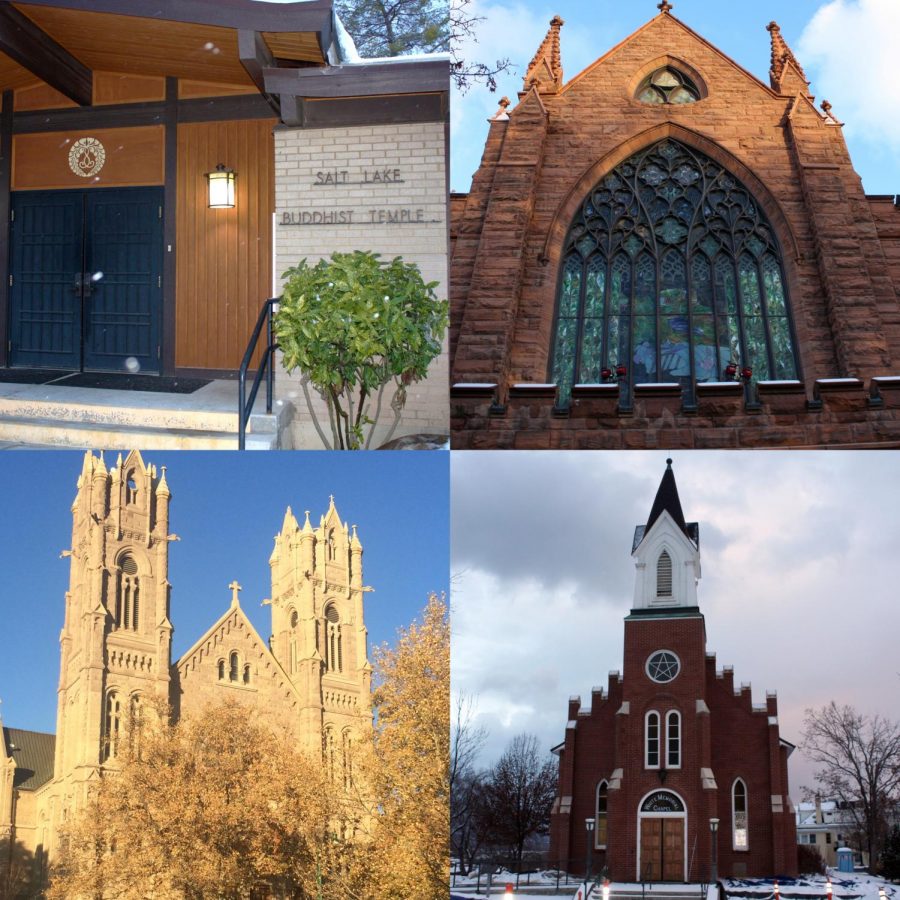A look at the divine through art
Top Left: Salt Lake Buddhist Temple Top Right: First Presbyterian Church of Salt Lake City Bottom Left: Cathedral of the Madeleine Bottom Right: White Memorial Chapel
December 13, 2018
People have long questioned, explored, and worshipped the existence of a divine being or force, or, in the case of polytheistic religions, multiple beings or forces. The form this being(s) takes, however, varies according to the doctrines and culture of each religion.
The perception of such a higher power also varies amongst Taylorsville High School students of different religious backgrounds.
Senior Zarina Khan, who is Muslim, said, “We don’t know how [Allah] looks. There’s no physical appearance talked about in our Holy Book or anywhere, so we don’t know how He looks. […] I don’t really see Him as a being, I see Him as a god who’s watching us, who’s taking care of us, who’s there to help us. Not really as a human being, though.”
Senior Brandon Gomez was raised in The Church of Jesus Christ of Latter Day Saints but now identifies as non-religious. He said, “I always thought of [God] as a man because in the cartoons you always see Him in the sky, He has a big long beard. You know, how everybody sees him. I guess not everybody, but what people say He looks like, and my dad always said He was a dude all the time, so I just thought He was a guy.”
And sophomore Jonas Painter, who is a member of The Church, said, “I believe that He doesn’t have a physical appearance. I see Him as an overall being that’s around us and stuff, and I kind of just see Him as all-knowing and all-seeing, but He doesn’t have a physical body on earth. But He does have a presence in a way. […] I try to keep my own image of God. [There are] many different interpretations of what He looks like or who He is, but [to] me personally, I see Him as just a man, and nothing too specific, just a person.”
These different interpretations arise in part from the various ways religions portray their beliefs in religious art.
Religious art can often be classified according to Western or Eastern religious art. Judaism, Christianity, and Islam are all examples of Western, or Abrahamic, religions. These religions adhere to the Ten Commandments, the second of which states that one must not create any “graven images” of God. This commandment has shaped how each of these religions depicts God in significant ways.
“Islam and Judaism do not show God because He is unlike anything on earth – to try and represent the image of God would be futile because there are no comparable beings. These instead focus on the name of God, and how it is written. Allah is the Arabic word for ‘God.’ It is not his name. In Hebrew, Yahweh is the transliterated version of God. This is the name of God in Judaism. Observant Jews, though, do not say his name or the transliterations of that name. Instead, they will use other words. They do not even write it,” said Mr. Rob Eberly, Taylorsville High School’s AP Art History teacher.
This strict adherence to the Second Commandment means that Islamic and Judaic religious artwork do not portray God in any physical form.
“It forces them to produce images that, for religious art, [focus] on pattern, on shape, on color rather than forms. So, in Islam you get Arabesque forms, you know, ornate plant motifs, or you get geometric patterns, geometry as an expression of the sacred. […] Judaism is going to copy a lot of what’s going on in Islam. Just patterning. […] When you get those [religious] images in Judaism, they’re going to be for private use, not for use in the synagogue […].” said Eberly.
Christian religious artwork follows a looser interpretation of the Second Commandment.
“Unlike Judaism and Islam, Christians have an access point to the divine in the form of Jesus. Because he is part human, part Divine, it became acceptable very early on to depict Christ and other holy beings. The key was abstraction – Christians abstracted their art to make it acceptable, and not an idol,” said Eberly.
Two major Eastern religions, Buddhism and Hinduism, differ from Western religions in a number of ways. One main difference is that Buddhism and Hinduism are not monotheistic. Hinduism is polytheistic, and Buddhism does not advocate for the worship of any single being. Rather, adherents to Buddhism focus on achieving Nirvana, an enlightened state in which one has finally broken the cycle of reincarnation, according to BBC.org. Anyone who has achieved enlightenment is considered a Buddha. Hindus also believe in reincarnation.
“In the Abrahamic traditions, […] we view creation as […] an expression of God’s creative ability. […] God’s the great artist, the great architect, in the Abrahamic, the Western traditions. And because of that, because He can’t help himself but create, we have so many diverse life forms. In the Eastern traditions, […] Buddhism, and Hinduism, it’s not like that. There was the cosmic oneness which was whole and it [broke]. And that’s why we have a multiplicity of forms. That’s why we have [an] infinite variety of things here on earth. So the goal is to rejoin the cosmic oneness, become whole again, so that […] all life is a little piece of that cosmic oneness and it gets incarnated, reincarnated until it’s able to break that cycle, to supersede that cycle, and come back and join the oneness,” said Eberly.
Additionally, because Eastern religions do not follow a doctrine similar to that of the Second Commandment, they conceptualize the divine in their physical forms.
“In Hinduism, you get the plurality of gods and they’re going to be the different colors. They’re going to be blue, they’re going to be, like I said, kind of different colors. They’re going to have multiple arms and or multiple heads, and the reason for that is because […] they’re going to […] show that these are not terrestrial beings, that they are otherworldly, that they’re from a divine space. So, they’ve got multiple […] appendages, to show their ability to act and to multitask, essentially, and to do different things. They’ve got different faces to show their different aspects,” said Eberly.
Buddhist religious art often focuses on Siddhartha Gautama, the creator of Buddhism.
“So the images that you see in Buddhism of a Buddha are oftentimes, Siddhartha Gautama, the original Buddha. Sometimes they’re the Vairocana Buddha, the Buddha before the world was. Or any number of other Buddhas that have existed. […] So in Buddhism you often see the Buddha depicted as serene. He’s going to have his hands in different positions. They’re called Mudras, and those positions indicate something that […] the artist is trying to convey about the Buddha in that moment,” said Eberly.
Such vast interpretations of the spiritual influence the way religious adherents perceive the higher power or powers they believe in. In this way, religious art shows both the doctrinal and personal perceptions of religious believers.





